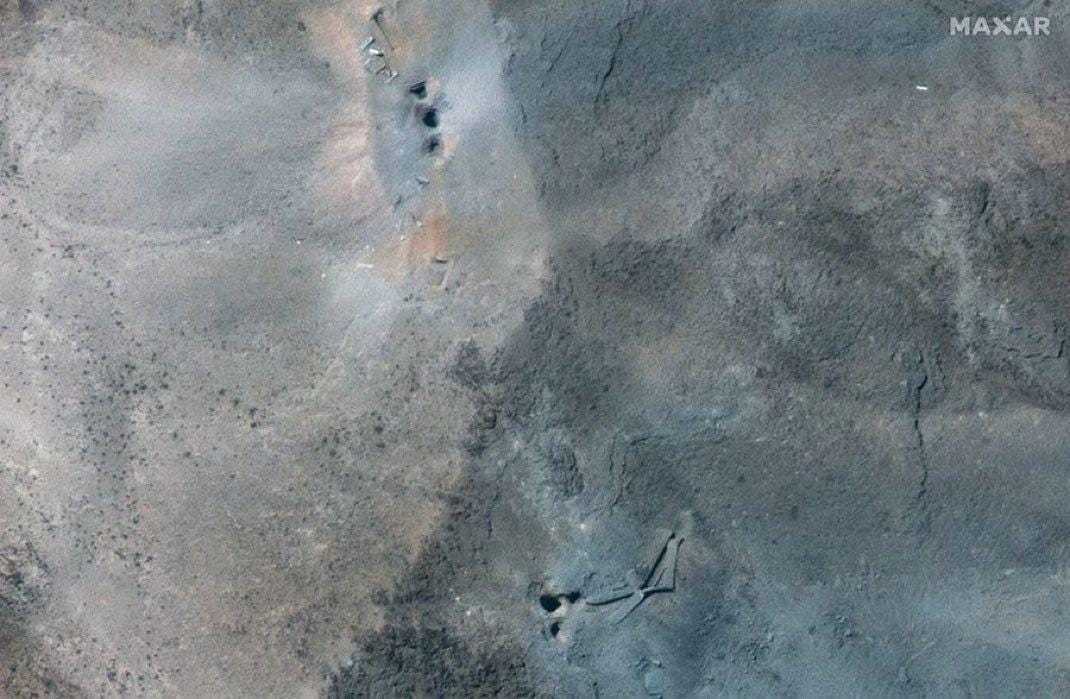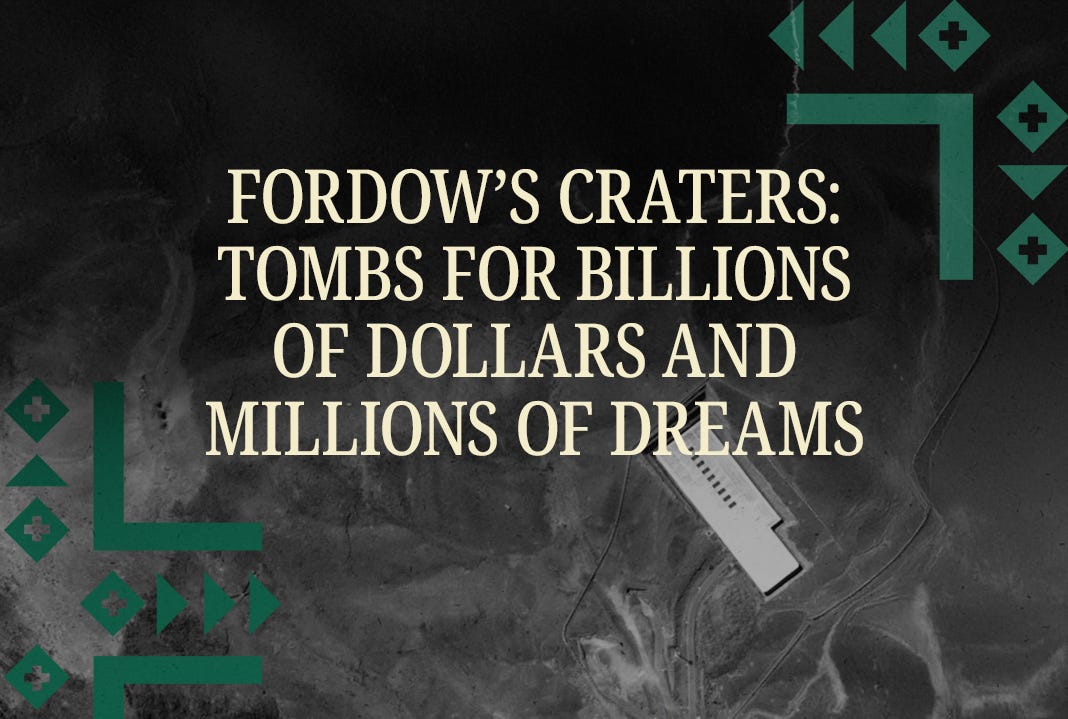Fordow’s Craters: Tombs for Billions of Dollars and Millions of Dreams
The Islamic Republic spent billions on nuclear tunnels instead of schools, hospitals, or power for its people.
More than twenty years after the Islamic Republic embarked on its nuclear program ostensibly to generate clean energy, the initiative stands as one of the nation’s largest money pits. While Tehran insists its objectives were peaceful, the financial reality tells another story. The direct and indirect costs associated with developing the program are estimated to exceed $100 billion. But this figure is dwarfed by the broader economic fallout.
A 2024 synthetic control study placed the cost of sanctions—imposed largely in response to the nuclear program—at roughly $1.2 trillion in lost GDP between 2011 and 2022, exceeding even the inflation-adjusted cost of the Iran-Iraq War. Add to that the lost foreign investment, blocked oil revenues, and years of economic isolation, and some sources estimate the total burden between two and three trillion dollars. In 2019, the U.S. State Department projected that sanctions on oil alone stripped up to $50 billion annually from Tehran’s coffers—around 40 percent of the regime’s entire budget at the time. Additional penalties resulting from sanctions evasion—such as reduced quality of trade goods and exorbitant intermediary fees—have cost the economy an estimated $30 billion per year.
In sum, a program marketed as an economic salvation has metastasized into a trillion-dollar trap. To grasp what $100 billion really means for ordinary Iranians, consider the public services they still lack.
In 2018, Iran’s entire education budget stood at $18 billion. The nuclear program’s direct cost alone could have funded five years of education for every child in the country. Tehran’s Line 6 subway extension—a 31-kilometer stretch—cost $5.8 billion. With $100 billion, Iran could have built the equivalent of 17 such lines, transforming public transit in Tehran, Mashhad, Isfahan, and Tabriz.
Healthcare provides an even starker counterfactual. In 2018, eight new hospitals were constructed for $120 million—about $15 million apiece. Redirecting nuclear funds could have yielded over 6,000 similar hospitals with nearly one million additional beds across underserved provinces. And that’s just the up-front spending. The $1.2 trillion in lost GDP could have been used to fund clean water infrastructure, reliable electricity, and world-class care instead of vanishing into a clandestine, ideological gamble.
As just one illustrative scenario—if the regime’s true aim had been to supply Iranians with clean power—its first $100 billion of nuclear spending could already have been fueling a national wind fleet. Iran is among the most wind-rich nations in the Middle East. Large regions—Zabol, Hamun, the Ardabil plain, parts of Fars and Bushehr, and the corridor between Paweh and Kermanshah—easily exceed the 5–6 m/s wind speed threshold needed for viable turbine deployment.
According to the U.S. Department of Energy, the average installed cost of new land-based wind capacity is roughly $1.7 million per megawatt. A $100 billion investment could have funded 20,000 modern 3-MW turbines, yielding 59 GW of installed capacity. Operating at the 2023 U.S. fleet’s average capacity factor of 33.5%, this network could produce approximately 173 TWh annually—enough to power all of Iran’s 24 million households and still leave 89 TWh for export. Under existing export agreements, such surplus could generate between $7 and $10 billion per year. Clean energy revenues rivaling a seventh of today’s sanctioned oil income without bunkers, bombs, or enrichment required.
These figures illustrate the opportunity cost and demonstrate Iran’s technical wind potential; turning it into real projects will depend on factors such as grid infrastructure, funding, and deployment pace. Under stable, democratic policies with normal access to international finance, much of its potential could be rapidly tapped.

What has the Islamic Republic delivered instead? Brutality. The same Revolutionary Guard units that bored Fordow into bedrock have repeatedly turned their weapons on unarmed civilians.
During “Bloody November” in 2019, at least 1,500 protesters, including at least 17 teenagers and around 400 women, were killed in under three days. Since the killing of Mahsa Jina Amini by the morality police in 2022, Iran’s “Woman, Life, Freedom” movement has recorded at least 551 additional protester deaths, 68 of them children. A 2024 UN fact-finding mission concluded the regime’s tactics—murder, torture, rape—amounted to crimes against humanity. In 2023 alone, the Islamic Republic carried out 834 executions, many after perfunctory trials designed to terrify the population. During the recent 12-day war, civilians were also killed once more, none of whom had ever been asked whether they endorsed the nuclear folly that turned their homeland into a battlefield.
The craters of Fordow are thus more than symbols of squandered billions; they are tombs in which an entire generation’s hopes and futures lie buried. During the oil boom era, when oil revenues could have laid the foundation for projects that would connect Iran to the global economy, the decisions of authoritarian rulers and the mafia-like groups surrounding them—who for years, under the guise of "clean energy," aspired to build nuclear weapons—marched a civilization toward downfall. Meanwhile, smaller neighbors with lesser geographic and geopolitical capacities, such as Qatar, the United Arab Emirates, and Saudi Arabia, transformed their oil revenues into vital arteries of large economies and opened a pathway to the vast ocean of the global economy. Fordow is just one of many scars the regime has carved into Iran—proof of how far a nation can fall when dictatorial, incompetent rulers squander fortunes on delusional ambitions instead of building their people’s future.
All dollar values mentioned above represent USD.
Middle East Uncovered is powered by Ideas Beyond Borders. The views expressed in Middle East Uncovered are those of the authors and do not necessarily reflect the views of Ideas Beyond Borders.






